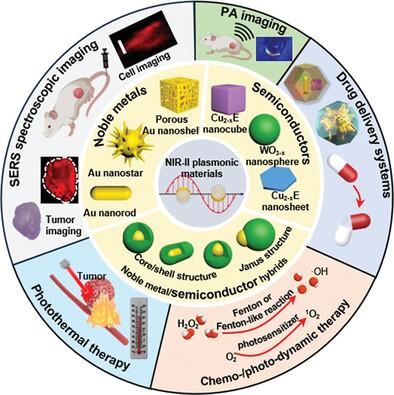当前位置:
X-MOL 学术
›
Adv. Funct. Mater.
›
论文详情
Our official English website, www.x-mol.net, welcomes your
feedback! (Note: you will need to create a separate account there.)
Rational Design of Near-infrared II Plasmonic Optofunctional Materials for Diagnostic and Therapeutic Applications
Advanced Functional Materials ( IF 18.5 ) Pub Date : 2024-01-18 , DOI: 10.1002/adfm.202312753
Yaxuan Lu 1 , Ming Li 1
Advanced Functional Materials ( IF 18.5 ) Pub Date : 2024-01-18 , DOI: 10.1002/adfm.202312753
Yaxuan Lu 1 , Ming Li 1
Affiliation

|
Plasmonic materials have aroused considerable interest in diagnostic and therapeutic biomedical applications because of their remarkable optical properties and the integration of multiple functionalities. Particularly, near-infrared II (NIR-II) plasmonic materials present great advantages for anticancer treatments, including deep tissue penetration, low tissue light scattering and autofluorescence, and high spatial resolution. Thus, NIR-II plasmonic phototheranostics represents a promising approach for effective anticancer treatments through multi-modal imaging-guided therapy. Accordingly, tremendous efforts have recently been devoted to the development of NIR-II plasmonic materials for highly efficient phototheranostics. In this review, the recent progress of NIR-II plasmonic materials and their phototheranostic applications are overviewed. First, the localized surface plasmon resonance effect and the related optical properties such as the photothermal effect, photoacoustic effect, and surface-enhanced Raman scattering (SERS) effect are introduced. Then, the unique features and the structure-property relationship of various types of NIR-II plasmonic materials are discussed. Finally, the recent progress of NIR-II plasmonic material-based multimodal phototheranostics with an emphasis on the integration of multiple functionalities are reviewed, and subsequently the current challenges and future research perspectives are discussed. This review will provide valuable guidelines for the rational design of NIR-II plasmonic materials for highly efficient cancer phototheranostics in the future.
中文翻译:

用于诊断和治疗应用的近红外 II 等离子体光电功能材料的合理设计
等离激元材料因其卓越的光学特性和多种功能的集成而引起了诊断和治疗生物医学应用的极大兴趣。特别是,近红外 II (NIR-II) 等离子体材料在抗癌治疗方面具有巨大的优势,包括深层组织穿透、低组织光散射和自发荧光以及高空间分辨率。因此,NIR-II 等离子体光治疗代表了一种通过多模式成像引导治疗进行有效抗癌治疗的有前途的方法。因此,最近人们致力于开发用于高效光治疗的 NIR-II 等离子体材料。本文综述了 NIR-II 等离子体材料及其光治疗应用的最新进展。首先,介绍了局域表面等离子体共振效应以及相关的光学特性,例如光热效应、光声效应和表面增强拉曼散射(SERS)效应。然后,讨论了各类NIR-II等离子体材料的独特特征和结构-性能关系。最后,回顾了基于 NIR-II 等离子体材料的多模态光疗的最新进展,重点是多种功能的集成,随后讨论了当前的挑战和未来的研究前景。本综述将为未来高效癌症光治疗的 NIR-II 等离子体材料的合理设计提供有价值的指导。
更新日期:2024-01-18
中文翻译:

用于诊断和治疗应用的近红外 II 等离子体光电功能材料的合理设计
等离激元材料因其卓越的光学特性和多种功能的集成而引起了诊断和治疗生物医学应用的极大兴趣。特别是,近红外 II (NIR-II) 等离子体材料在抗癌治疗方面具有巨大的优势,包括深层组织穿透、低组织光散射和自发荧光以及高空间分辨率。因此,NIR-II 等离子体光治疗代表了一种通过多模式成像引导治疗进行有效抗癌治疗的有前途的方法。因此,最近人们致力于开发用于高效光治疗的 NIR-II 等离子体材料。本文综述了 NIR-II 等离子体材料及其光治疗应用的最新进展。首先,介绍了局域表面等离子体共振效应以及相关的光学特性,例如光热效应、光声效应和表面增强拉曼散射(SERS)效应。然后,讨论了各类NIR-II等离子体材料的独特特征和结构-性能关系。最后,回顾了基于 NIR-II 等离子体材料的多模态光疗的最新进展,重点是多种功能的集成,随后讨论了当前的挑战和未来的研究前景。本综述将为未来高效癌症光治疗的 NIR-II 等离子体材料的合理设计提供有价值的指导。

































 京公网安备 11010802027423号
京公网安备 11010802027423号